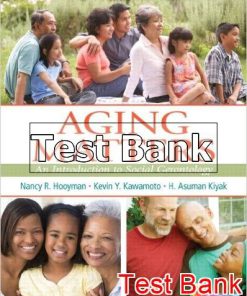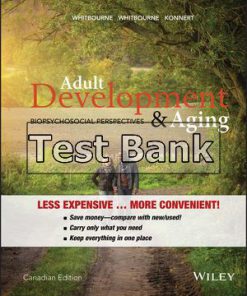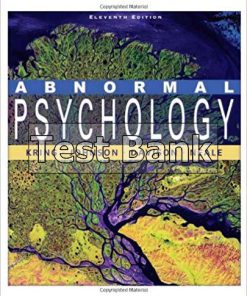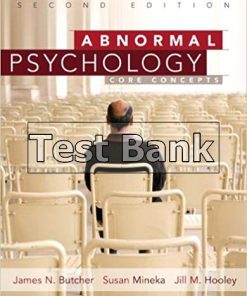Aging Matters 1st Edition Hooyman Test Bank
You may also like
This is completed downloadable of Aging Matters 1st Edition Hooyman Test Bank

Product Details:
- ISBN-10 : 0133974022
- ISBN-13 : 978-0133974027
- Author:
Aging Matters illuminates cultural, biological, physiological, emotional, cognitive, economic, and social aspects of aging. A useful guide to a range of disciplines, this title helps readers of all educational backgrounds understand the dynamic interactions between older people and their environments.
Table of Content:
- I.2 Why Study Gerontology?
- I.2.1 A Life Course and Strengths Perspective
- I.2.2 Multidisciplinary Perspective
- I.3 Key Terms
- I.3.1 How Do We Define Age?
- I.4 How Do We Study Older Adults?
- I.4.1 Research Methods
- Summary
- An Introduction to Social Gerontology
- Chapter 1 The Older Population in the United States
- Learning Objectives
- Introduction The Older Population in the United States
- 1.1 Changing Demographics of the U.S. Population
- 1.1.1 Changes in Life Expectancy
- 1.1.2 Gender Differences in Life Expectancy
- 1.1.3 Racial Differences in Life Expectancy
- 1.2 Maximum Life Span
- 1.2.1 Population Pyramids
- 1.3 Support and Dependency Ratios
- 1.4 The Rapid Growth of the Old-Old and Oldest-Old
- 1.4.1 Who Are the Oldest-Old?
- 1.4.2 Centenarians and Super-Centenarians
- The Role of Genes
- Evidence for a Genetic Role in Becoming a Centenarian
- Aging Well as Centenarians and Oldest-Old
- The Role of the Environment
- 1.5 Increasing Diversity among the Older Population
- 1.5.1 Elders of Color
- 1.5.2 Lesbian, Gay, Bisexual, and Transgender (LGBT) Elders
- 1.5.3 Geographic Distribution
- 1.5.4 Geographic Distribution among Elders of Color
- 1.5.5 Educational and Economic Status
- 1.6 Longevity in Health or Disease? What Does the Future Hold?
- Summary
- The Older Population in the United States
- Chapter 2 Global Aging and Older Immigrants in the United States
- Learning Objectives
- Introduction Global Aging and Older Immigrants in the United States
- 2.1 Global Trends in Aging
- 2.1.1 Global Aging, Median Age, and Population Pyramids
- Median Age
- 2.1.2 What It Means To Be Old around the World
- Baby Boomers in Japan
- 2.2 Economic Implications for Industrialized Countries
- 2.3 Older Europeans in the Workforce
- 2.4 Older Adults in Traditional Societies and the Impact of Modernization
- 2.4.1 Modernization Theory
- 2.4.2 Modernization and Elders’ Declining Social Status
- 2.4.3 Impact of Modernization on Respect and Care toward Elders in Asian Cultures
- 2.5 Immigrants to the United States
- 2.5.1 Immigrant Elders’ Changing Roles and Expectations
- 2.5.2 Financial Dilemmas Facing Immigrant Elders
- 2.5.3 Immigrant Elders in Multigenerational Households
- 2.5.4 Additional Challenges Faced by Older Refugees
- Summary
- Global Aging and Older Immigrants in the United States
- Chapter 3 Physical Well-Being Physiological Changes and Health
- Learning Objectives
- Introduction Physical Well-Being: Physiological Changes and Health
- 3.1 Biological Theories of Aging
- 3.1.1 Can Aging Be Reversed or Delayed?
- 3.2 “Normal” Physiological Changes with Age
- 3.2.1 Changes in Body Composition
- 3.2.2 Changes in the Skin and Hair
- 3.2.3 Organ Systems
- Musculoskeletal and Kinesthetic Systems
- Respiratory System
- Cardiovascular Changes
- Urinary System
- Gastrointestinal System
- Endocrine System
- Immune System
- Nervous System
- 3.2.4 Physiological Changes and Sexuality
- Women and Age-Related Physiological Changes
- Men and Age-Related Physiological Changes
- 3.2.5 Sleep Patterns
- 3.2.6 Sensory Functions
- Vision
- Hearing
- Taste and Smell
- Touch
- 3.3 Defining Health and Functional Ability
- 3.3.1 Are Disability Rates Declining?
- 3.3.2 Chronic and Acute Diseases
- 3.3.3 Health Disparities
- 3.3.4 Primary Causes of Death in Old Age
- 3.4 Common Chronic Diseases
- 3.4.1 Heart Disease and the Cardiovascular System
- 3.4.2 Strokes and Other Cerebrovascular Problems
- 3.4.3 Cancer
- 3.4.4 Arthritis
- 3.4.5 Osteoporosis or “Weak Bones”
- 3.4.6 Chronic Obstructive Pulmonary Disease or Respiratory Problems
- 3.4.7 Diabetes
- 3.4.8 Problems with the Kidneys and Urinary Tract
- 3.4.9 Problems with the Intestinal System
- 3.4.10 Oral Diseases
- 3.4.11 HIV (Human Immunodeficiency Virus) or AIDS (Acquired Immune Deficiency Syndrome)
- 3.5 Accidents
- 3.5.1 Older Drivers
- 3.5.2 Falls and Their Prevention
- 3.6 Use of Physician Services
- 3.6.1 Hospital Utilization
- 3.6.2 Medication Use
- 3.7 Health Promotion
- 3.7.1 Exercise as Central to Health Promotion
- 3.7.2 Nutrition
- 3.7.3 Programs That Work
- 3.7.4 Improving the Impact of Health Promotion Programs
- Summary
- Physical Well-Being: Physiological Changes and Health
- Chapter 4 Mental and Emotional Well-Being
- Learning Objectives
- Introduction Mental and Emotional Well-Being
- 4.1 Aging and Cognitive Function
- 4.1.1 Intelligence and Aging
- 4.1.2 What Else Besides Age Affects Intelligence?
- 4.1.3 How Aging Affects Learning and Memory
- 4.1.4 Executive Function in Older Adults
- Factors that Affect Learning in Old Age
- Strategies to Promote Older Adults’ Learning
- Age-Related Changes in Memory
- 4.1.5 Improving Cognitive Abilities
- 4.1.6 Memory Mediators
- External Cognitive Aids
- 4.1.7 Physical Exercise
- Do Chemical Aids Improve Memory?
- 4.1.8 Wisdom and Creativity
- 4.2 Personality in the Later Years
- 4.2.1 Stage Theories of Personality
- Erikson’s Psychosocial Model of Personality
- 4.2.2 Trait Theories of Personality
- 4.2.3 Emotional Expression and Regulation
- 4.2.4 Self-Concept and Self-Esteem
- 4.2.5 Successful, Robust, Resilient, or Positive Aging
- 4.3 Mental Disorders among Older Persons
- 4.3.1 Depression
- Risk Factors for Depression
- Diagnosing Depression
- Therapeutic Interventions
- 4.3.2 Suicide
- 4.3.3 Anxiety
- 4.3.4 Paranoia and Schizophrenia
- 4.3.5 Older Adults Who Are Chronically or Severely Mentally Ill
- 4.3.6 Dementia
- Reversible and Irreversible Causes of Dementia
- 4.3.7 Alzheimer’s Disease (AD)
- Differentiating AD from Normal Age-Related Memory Changes
- Potential Causes of and Risk Factors for Alzheimer’s Disease
- The Importance of a Thorough Diagnosis
- Stages of Alzheimer’s Disease
- Drug Therapy
- Behavioral Treatment and Environmental Interventions
- Parkinson’s Disease
- 4.3.8 Substance Use
- Alcoholism
- Drug Abuse
- Medication Misuse Can Threaten Elders’ Independence
- Summary
- Mental and Emotional Well-Being
- Chapter 5 Social Theories of Aging
- Learning Objectives
- Introduction Social Theories of Aging
- 5.1 The Importance of Social Theories of Aging
- 5.2 Social Gerontological Theory before 1961 Role and Activity
- 5.2.1 Role Theory
- Age Norms
- Role Loss
- 5.2.2 Activity Theory
- 5.3 The Next Stage of Theory Development Disengagement and Continuity Theory
- 5.3.1 Disengagement Theory
- 5.3.2 Continuity Theory
- 5.4 Newer Social Theoretical Perspectives
- 5.4.1 Age Stratification Theory
- 5.4.2 Social Exchange Theory
- 5.4.3 Life Course Perspective
- 5.4.4 Political Economy Theory of Aging
- 5.4.5 Social Constructionism
- 5.5 Recent Developments in Social Gerontological Theory
- 5.5.1 Social Phenomenology
- 5.5.2 Feminist Gerontology
- 5.5.3 The Interconnections of Gender, Race, and Sexual Orientation
- Summary
- Social Theories of Aging
- Chapter 6 Family, Friends, and Other Informal Supports
- Learning Objectives
- Introduction Family, Friends, and Other Informal Supports
- 6.1 We All Need Informal Social Support
- 6.1.1 The Benefits of Social Supports
- 6.1.2 Do Social Supports Change as We Age?
- 6.1.3 What Factors Affect Our Social Relationships?
- 6.2 The Centrality of Family Supports
- 6.2.1 Families Are Changing
- 6.2.2 The Growth of the Multigenerational Family
- 6.3 Older Partners as Social Support
- 6.3.1 Older Adults and Marriage
- Marital Satisfaction
- Divorce in Old Age
- Remarriage and Other Late-Life Romantic Relationships
- Dating in Old Age
- 6.3.2 Never-Married Older People
- 6.3.3 Childless Older Adults
- 6.4 Lesbian, Gay, Bisexual, and Transgender (LGBT) Partners
- 6.4.1 What We Now Know about Older LGBT Families
- 6.4.2 Effects of Race, Class, and Cohort with Sexual Identity
- LGBT Elder-Friendly Organizations
- 6.4.3 Barriers to Supports for LGBT Elders
- 6.4.4 Working with LGBT Elders
- 6.5 Sexuality, Intimacy, and Emotional Support
- 6.5.1 What We Know about Older Adults and Sexuality
- 6.6 Other Types of Family Supports
- 6.6.1 Relationships with Adult Children
- 6.6.2 Sibling Relationships
- 6.6.3 Grandparenthood and Great-Grandparenthood
- 6.6.4 Friends and Neighbors as Social Supports
- Programs to Strengthen or Build Neighborhood and Community Supports
- Intergenerational Programs
- 6.6.5 The Unconditional Love of Pets
- Summary
- Family, Friends, and Other Informal Supports
- Chapter 7 Informal and Family Caregiving
- Learning Objectives
- Introduction Informal and Family Caregiving
- 7.1 What Is Informal Caregiving?
- 7.1.1 What Kind of Informal Care Do Some Older Adults Need?
- 7.1.2 Who Are Informal Caregivers?
- 7.1.3 Losses and Gains of Informal Care
- Costs of Informal Caregiving
- Benefits of Informal Caregiving
- 7.1.4 Adult Children as Caregivers
- The Gendered Nature of Caregiving
- Women in the Middle
- 7.1.5 Spouses/Partners as Caregivers
- 7.1.6 Family Caregivers of Color
- 7.1.7 Friends as Caregivers
- 7.1.8 Caregiving for Persons with Dementia
- 7.1.9 Grandparents as Primary Caregivers
- 7.1.10 Legal Issues Related to Grandparent Caregiving
- 7.1.11 Legislation and Policies to Support Family Caregivers
- 7.2 Services and Support for Caregivers
- 7.2.1 Why Don’t Caregivers Use Services?
- 7.2.2 Effective Evidence-Based Interventions
- Psychoeducational Groups, Skills Training, and Treatments
- Support Groups
- Modifying the Home Environment
- Respite Care
- Camps for Caring
- Electronic Supports
- 7.2.3 Future Service Directions
- 7.3 When Caregiving Becomes Too Much
- 7.3.1 Placement in Long-Term Care Facilities
- 7.3.2 Elder Mistreatment
- Financial Abuse and Exploitation
- Reporting and Other Legal Requirements
- Adult Protective Services
- 7.4 Underpaid Caregivers Direct Care Workers
- 7.4.1 Economic and Health Disparities Faced by Direct Care Workers
- 7.4.2 Future Demand
- Summary
- Informal and Family Caregiving
- Chapter 8 Productive Aging Leisure, Spirituality, and Civic Engagement
- Learning Objectives
- Introduction Productive Aging: Leisure, Spirituality, and Civic Engagement
- 8.1 Defining Productive Aging
- 8.2 Leisure
- 8.3 Religious Participation, Religiosity, and Spirituality
- 8.3.1 Defining Religion, Religiosity, and Spirituality
- 8.3.2 Religious Affiliation
- Age, Gender, and Race
- 8.3.3 Religiosity
- Benefits of Religious Participation and Religiosity for Older Adults
- Other Factors to Consider Regarding Religion and Health
- 8.3.4 Spiritual Well-Being
- Implications for Health Care Providers
- Stages of Spiritual Growth
- 8.4 Civic Engagement
- 8.4.1 Civic Engagement
- Toward What End?
- 8.4.2 Membership in Voluntary Associations
- Patterns of Membership
- 8.4.3 Senior Centers
- Are They Prepared for Changing Demographics?
- 8.4.4 Volunteering
- Benefits of Volunteerism
- Race, Social Class, and Volunteering
- 8.4.5 Lifelong Learning Programs
- 8.4.6 Political Participation
- Do Older Adults Become More Politically Conservative with Age?
- Voting Behavior
- Are Older Adults a Powerful Political Constituency?
- 8.4.7 AARP—The Largest Membership Organization in the Country
- Is AARP for All Older Adults?
- 8.4.8 Looking Toward the Future of Productive Aging
- Summary
- Productive Aging: Leisure, Spirituality, and Civic Engagement
- Chapter 9 Loss and Grief in Old Age
- Learning Objectives
- Introduction Loss and Grief in Old Age
- 9.1 Loss and Grief within the Context of Aging
- 9.1.1 The Nature of Grief
- 9.1.2 Typical Losses Faced by Older Adults
- Relocation
- Retirement
- Caring for a Relative with Chronic Illness or Disability
- Caring for Adult Children with Chronic Illness or Disabilities
- Living with Chronic Illness or Disability
- 9.2 Death of Loved Ones
- 9.2.1 Death of a Partner
- 9.2.2 Death of Siblings
- 9.2.3 Death of Friends
- 9.3 Approaching One’s Own Death and the Dying Process
- 9.3.1 The Dying Process
- 9.3.2 Desire for a Good Death
- 9.3.3 End-of-Life Care
- Palliative Care and Hospice
- 9.3.4 Culturally Appropriate End-of-Life Care
- 9.3.5 The Right to Die
- Hastened Death and Physician Aid-in-Dying
- Patients’ Legal Options Regarding Their End-of-Life Care
- Summary
- Loss and Grief in Old Age
- Chapter 10 Economic Well-Being Retirement, Employment, and Poverty
- Learning Objectives
- Introduction Economic Well-Being: Retirement, Employment, and Poverty
- 10.1 Retirement
- 10.1.1 Baby Boomers and Changing Expectations of Retirement
- 10.1.2 The Timing of Retirement
- 10.2 Employment
- 10.2.1 Unemployment
- 10.2.2 Barriers to Employment
- 10.3 Economic Status
- 10.3.1 What Are the Major Sources of Income for Older Adults?
- Social Security
- Assets
- Pensions Other Than Social Security
- Earnings
- Public Assistance
- 10.3.2 Social Class and Poverty in Old Age
- Are Older Adults Poorer Than Other Age Groups?
- Limitations of Official Poverty Statistics
- Poverty Variations by Race, Gender, and Sexual Orientation
- 10.3.3 Hunger Is Increasing among Older Americans
- 10.4 Changing Conceptions of Work and Retirement
- Summary
- Economic Well-Being: Retirement, Employment, and Poverty
- Chapter 11 Community Well-Being Living Arrangements and Social Interactions
- Learning Objectives
- Introduction Community Well-Being: Living Arrangement and Social Interactions
- 11.1 The Aging Experience in Rural, Urban, and Suburban Areas
- 11.1.1 How and Where Elders Live Affects Their Well-Being
- 11.1.2 Relocation
- 11.2 Housing Patterns of Older People
- 11.2.1 Independent Housing
- 11.2.2 Aging in Place
- Age-Friendly/Livable Communities
- Flexible Housing and Universal Design
- Additional Innovations for Aging in Place
- 11.2.3 Planned “Retirement” Housing
- Continuing Care Retirement Communities
- Assisted Living
- Private Homes that Offer Long-Term Supports
- Skilled Nursing Facilities (SNFS)
- 11.2.4 Culture Change in Long-Term Care
- 11.3 Social and Health Services to Promote Aging in Place
- 11.3.1 Home Care
- 11.3.2 Adult Day Care and Adult Day Health Care
- 11.4 Housing Policy and Growing Housing Needs
- 11.4.1 Homelessness Aging in Place on the Streets
- 11.4.2 Aging in Place among Older Prisoners
- Summary
- Community Well-Being: Living Arrangements and Social Interactions
- Chapter 12 Enhancing Older Adults’ Well-Being through Technology
- Learning Objectives
- Introduction Enhancing Older Adults’ Well-Being through Technology
- 12.1 Information and Communication Technologies
- 12.1.1 Intergenerational Communication
- 12.1.2 Lifelong Learning
- 12.1.3 News and Information
- 12.2 Managing Health Online
- 12.2.1 Health Information on the Internet
- 12.2.2 Health Plans Online
- 12.2.3 Telehealth
- 12.2.4 Health Consultation Online
- 12.3 Technology in the Workplace
- 12.4 Technologies to Help Aging in Place
- 12.4.1 Universal Design
- 12.4.2 Smart Homes
- Researching Smart Homes and Universal Design
- 12.4.3 Gerontechnology
- Remote Patient Monitoring
- 12.4.4 Developing Technologies for Older Adults
- 12.5 Can Computer Games Promote Elders’ Well-Being?
- 12.5.1 Computer Games and Physical Exercise
- Summary
- Enhancing Older Adults’ Well-Being through Technology
- Chapter 13 Policies to Promote Older Adults’ Well-Being
- Learning Objectives
- Introduction Policies to Promote Older Adults’ Well-Being
- 13.1 Understanding Policies, Programs, and Regulations
- 13.1.1 Separating Fact from Fiction about Age-Based Policies
- 13.1.2 Criteria by Which Policies Vary
- 13.1.3 Factors That Influence the Development of Public Policies
- Values Affecting Social Policy
- 13.1.4 Intergenerational Inequity versus Interdependence
- 13.2 Historical, Economic, and Political Context
- 13.2.1 The First Policies to Benefit Older Americans, 1930s–1950s
- 13.2.2 Expansion of Age-Based Programs in the 1960s and 1970s
- “Compassionate Stereotypes” about Older Adults
- 13.2.3 Cost Efficiency and Program Reductions in the 1980s and 1990s
- 13.2.4 Since 2000
- Market and Personal Responsibility and Reduced Government Spending
- 13.3 Social Security An Income Security Program
- 13.3.1 The Goals of Social Security
- 13.3.2 The Cross-Generational Nature of Social Security
- 13.3.3 The Future of Social Security
- Proposed Changes to Social Security
- Proposals to Reduce Gender Inequities in Social Security
- 13.4 Social Services through the Older Americans Act
- 13.5 Medicare and Medicaid
- 13.5.1 Medicare
- Medicare-Funded Home Health Care
- Medicare Reform and Prescription Drug Coverage
- The Future of Medicare
- 13.5.2 Medicaid
- Medicaid-Funded Skilled Nursing Home Care
- Medicaid-Funded Home Health Care
- 13.6 Directions in Long-term Services and Supports
- 13.6.1 Long-Term Care Insurance
- 13.6.2 Policies to Promote Innovative Health and Long-Term Care Services
- 13.6.3 Benefits of Health Care Reform for Older Adults
- Summary
- Policies to Promote Older Adults’ Well-Being
- Chapter 14 Careers in Aging
- Learning Objectives
- Introduction Careers in Aging
- 14.1 Why Consider a Career in Aging?
- 14.2 The Wide Range of Jobs in Aging
- 14.3 Preparing for a Career in Aging
- 14.3.1 Academic Programs in Aging
- Workforce Initiatives in Medicine, Nursing, and Social Work
- Interdisciplinary Teams
- 14.3.2 Internships and Other Training Opportunities
- Journaling as a Self-Discovery Tool
- 14.4 A Multidisciplinary, Multigenerational Outlook
- Summary
- Careers in Aging
- Glossary
- References
- Credits
- Introduction
- Chapter 1
- Chapter 2
- Chapter 3
- Chapter 4
- Chapter 5
- Chapter 6
- Chapter 7
- Chapter 8
- Chapter 9
- Chapter 10
- Chapter 11
- Chapter 12
- Chapter 13
- Chapter 14
- Index
- A
- B
- C
- D
- E
- F
- G
- H
- I
- J
- K
- L
- M
- N
- O
- P
- Q
- R
- S
- T
- U
- V
- W
- Y
People Also Search:
aging matters hooyman
aging matters 1st edition hooyman
aging matters 1st edition
aging matters 1st edition download scribd
aging matters 1st edition testbank download pdf
aging matters
aging matters hooyman pdf












